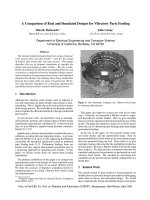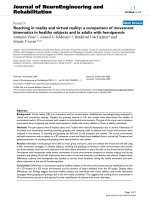a comparison of sip and h.323 for internet telephony
Bạn đang xem bản rút gọn của tài liệu. Xem và tải ngay bản đầy đủ của tài liệu tại đây (35.88 KB, 4 trang )
1
A Comparison of SIP and H.323 for Internet
Telephony
Henning Schulzrinne Jonathan Rosenberg
Dept. of Computer Science, Columbia University Bell Laboratories
New York, NY 10027 Holmdel, NJ 07733
Abstract—Two standards have recently emerged for signaling and con-
trol for Internet Telephony. One is ITU Recommendation H.323, and the
other is the IETF Session Initiation Protocol (SIP). These two protocols rep-
resent very different approaches to the same problem: H.323 embraces the
more traditional circuit-switched approach to signaling based on the ISDN
Q.931 protocol and earlier H-series recommendations, and SIP favors the
more lightweight Internet approach based on HTTP. In this paper, we com-
pare SIP and H.323 on complexity, extensibility, scalability, and features.
I. INTRODUCTION
In order to provide useful services, Internet telephony re-
quires a set of control protocols for connection establishment,
capabilities exchange, and conference control. Currently, two
protocols exist to meet this need. One is ITU-T H.323, and the
other is the IETF Session Initiation Protocol (SIP). In this pa-
per, we compare the two protocols on complexity, extensibility,
scalability, and services.
The ITU H.323 series of recommendations (“Packet Based
Multimedia Communications Systems”) defines protocols and
procedures for multimedia communications on, among other
things, the Internet. It includes H.245 for control, H.225.0 for
connection establishment, H.332 for large conferences, H.450.1
H.450.2 and H.450.3 for supplementary services, H.235 for se-
curity, and H.246 for interoperability with circuit-switched ser-
vices. H.323 started out as a protocol for multimedia commu-
nication on a LAN segment without QoS guarantees, but has
evolved to try and fit the more complex needs of Internet tele-
phony.
H.323 is based heavily on the ITU multimedia protocols
which preceded it, including H.320 for ISDN, H.321 for B-
ISDN, and H.324 for GSTN terminals. The encoding mecha-
nisms, protocol fields, and basic operation are somewhat sim-
plified versions of the Q.931 ISDN signaling protocol.
The Session Initiation Protocol (SIP) [1], developed in the
MMUSIC working groupof the IETF, takes a different approach
to Internet telephony signaling by reusing many of the header
fields, encoding rules, error codes, and authentication mecha-
nisms of HTTP.
In both cases, multimedia data will likely be exchanged via
RTP, so that the choice of protocol suite does not influence In-
ternet telephony QOS.
II. COMPLEXITY
H.323 is a rather complex protocol. The sum total of the
base specifications alone (not including ASN.1 and PER) is 736
pages. SIP, on the other hand, along with its call control exten-
sions and session description protocols totals merely 128 pages.
H.323 defines hundreds of elements, while SIP has only 37
headers (32 in the base specification, 5 in the call control exten-
sions), each with a small number of values and parameters, but
that contain more information. A basic, but interoperable SIP
Internet telephony implementation can get by with four headers
(To, From, Call-ID,andCSeq) and three request types (IN-
VITE, ACK,andBYE) and is small enough to be assigned as a
homework programming problem. A fully functional SIP client
agent, with a graphical user interface, has been implemented in
just two man-months.
H.323 uses a binary representation for its messages, based
on ASN.1 and the packed encoding rules (PER). ASN.1 gener-
ally requires special code-generators to parse. SIP, on the other
hand, encodes its messages as text, similar to HTTP [2] and the
Real Time Streaming Protocol (RTSP) [3]. This leads to simple
parsing and generation, particularly when done with powerful
text processing languages such as Perl. The textual encoding
also simplifies debugging, allowing manual entry and perusing
of messages. Its similarity to HTTP also allows for code-reuse;
existing HTTP parsers can be quickly modified for SIP usage.
H.323’s complexity also stems from its use of several pro-
tocol components. There is no clean separation of these com-
ponents; many services require interactions between several
of them. (Call forward, for example, requires components of
H.450, H.225.0, and H.245.) The use of several different pro-
tocols also complicates firewall traversal. Firewalls must act as
application level proxies [4], parsing the entire message to ar-
rive at the required fields. The operation is stateful since several
messages are involved in call setup. SIP, on the other hand, uses
a single request that contains all necessary information.
H.323 also provides for an array of options and methods for
accomplishing a single task. For example, there are three dis-
tinct ways in which H.245 and H.225.0 may be used together:
the original H.323v1 approach of separate connections, H.245
tunneling through H.225.0, and FastStart in H.323v2. In the
original approach, the call signaling channel is set up first, the
H.245 control channelis established, and finally the media chan-
nels areopened. This can require many round trips forcall setup.
FastStart includes the media channel information in the origi-
nal call invitation, avoiding the need to open the H.245 chan-
nel. In H.245 tunnelling, the H.245 channel is still used, but
its messages are carried over the call signaling channel. Even
though FastStart is much more efficient, H.323 allows any of
2
the three and thus, firewalls, end systems, gatekeepers, and gate-
ways must support all of them. As with any protocol, large op-
tion spaces lead to feature interaction and the need for profiles.
(How does encryption of the H.245 channel work when its tun-
neled through H.225.0, for example?).
An additional aspect of H.323’s complexity is its duplication
of some of the functionality present in other parts of the pro-
tocol. In particular, H.323 makes use of RTP and RTCP. RTCP
has been engineered to providevarious feedback and conference
control functions in a manner which scales from two-party con-
ferences to thousand-party broadcast sessions. H.245, however,
provides its own mechanisms for both feedback and simple con-
ference control (such as obtaining the list of conference partici-
pants). These H.245 mechanisms are redundant, and have been
engineered for small to medium-sized conferences only.
III. EXTENSIBILITY
Extensibility is a key metric for measuring an IP telephony
signaling protocol. Telephony is a tremendously popular, criti-
cal service, and Internet telephony is poised to supplant the ex-
isting circuit switched infrastructure developed to support it. As
with any heavily used service, the features provided evolve over
time as new applications are developed. This makes compat-
ibility among versions a complex issue. As the Internet is an
open, distributed, and evolving entity, one can expect extensions
to IP telephony protocols to be widespread and uncoordinated.
This makes it critical to build in powerful extension mechanisms
from the outset.
SIP has learned the lessons of HTTP and SMTP (both of
which are widely used protocols that have evolved over time),
and built in a rich set of extensibility and compatibility func-
tions. By default, unknown headers and values are ignored.
Using the Require header, clients can indicate named feature
sets that the server must understand. When a request arrives at
a server, it checks the list of named features in the Requires
header. If any of them are not supported, the server returns an
error code and lists the set of features it does understand. The
client can then determine the problematic feature and fall back
to simpler operation. The feature names are based on a hierar-
chical namespace, and new feature names can be registered with
IANA. This means that any developer can create new features in
SIP, and then simply register a name for them. Compatibility is
still maintained across different versions.
To further enhance extensibility, numerical error codes are hi-
erarchically organized, as in HTTP. There are six basic classes,
each of which is identified by the hundreds digit in the response
code. Basic protocol operation is dictated solely by the class,
and terminals need only understand the class of the response.
The other digits provide additional information, usually use-
ful but not critical. This allows for additional features to be
added by defining semantics for the error codes in a class, while
achieving compatibility.
The textual encoding means that header fields are self-
describing. It is self-evident what the meaning of the To, From,
and Subject fields are. As new header fields are added in vari-
ous different implementations, developers in other corporations
can determine usage just from the name, and add support for
the field. This kind of distributed, documentation-less standard-
ization has been common in the Simple Mail Transfer Protocol
(SMTP), which has evolved tremendously over the years.
As SIP is similar to HTTP, mechanisms being developed for
HTTP extensibility can also be used in SIP. Among these are
the Protocol Extensions Protocol (PEP), which contains point-
ers to the documentation for various features within the HTTP
messages themselves.
H.323 provides extensibility mechanisms as well. These are
generallynonstandardParam fields placed in various locations
in the ASN.1. These params contain a vendor code, followed by
an opaque value which has meaning only for that vendor. This
does allow for differentvendors to developtheir own extensions.
However, it has some limitations. First, extensions are limited
only to those places where a non-standard parameter has been
added. If a vendor wishes to add a new value to some existing
parameter, and there is no placeholder for a nonstandard ele-
ment, one cannot be added. Secondly, H.323 has no mechanisms
for allowing terminals to exchange information about which ex-
tensions each supports. As the values in non-standard param-
eters are not self-describing, this limits interoperability among
terminals from different manufacturers.
In addition, H.323 requires full backwards compatibility from
each version to the next. As various features come and go, the
size of the encodings will only increase. However, SIP allows
for older headers and features to gradually disappear as they are
no longer needed, keeping the protocol and its encoding clean
and concise.
A critical issue for extensibility are audio and video codecs.
There are hundreds of codecs that have been developed, many
of which are proprietary. SIP uses the Session Description Pro-
tocol (SDP) to convey the codecs supported by an endpoint in
a session. Codecs are identified by string names, which can be
registered by any person or group with IANA, and then used.
This means that SIP can work with any codec, and other imple-
mentations can determine the name of the codec, and contact
information for it, from IANA.
In H.323, each codec must be centrally registered and stan-
dardized. Currently, only ITU developed codecs have code-
points. As many of these carry significant intellectual property,
there is no free, sub-28.8 kb/s codec which can be used in an
H.323 system. This presents a significant barrier to entry for
small players and universities.
Furthermore, SIP allows for new services to be defined
through a few powerful third-party call control mechanisms.
These mechanisms allow a third party to instruct another entity
to create and destroy calls to other entities. As the controlled
party executes the instructions, status messages are passed back
to the controller. This allows the controller to take further ac-
tions based on some local program execution. This is much
like the IN model in traditional telephony. As there are hun-
dreds of telephony services currently defined, it is unreasonable
to attempt to write specifications for each. SIP allows these
services to be deployed by basing them on simple, standard-
ized mechanisms. These mechanisms can be used to construct
a variety of services, including blind transfer, operator assisted
transfer, three-party calling, bridged calling, dial-in bridging,
multi-unicast to multicast transitions, ad-hoc bridge invitation
and transition, and various forwarding variations [5].
3
As an example of these extension and service creation mech-
anisms, the PSTN and Internet Internetworking (pint) working
group in IETF is defining a simple SIP extension for click-to-
call type of services. In this scenario, a user at a web page clicks
on a button, and a PSTN entity connects the user’s telephone to
a customer service rep. This requires a control protocol between
the web server and a PSTN-enabled device. SIP is being used
as this protocol.
H.323 does provide some basic mechanisms along this line.
The FACILITY message allows a callee to direct a caller to con-
tact a different party (basically, a blind transfer). Another is
the H.245 CommunicationModeCommand, which allows the
MC to change the media encodings for a conference for the var-
ious participants. The former is fairly limited in scope, and the
latter can only be executed by the MC for the call. Neither pro-
vide generic third party control mechanisms needed for building
complex services.
Another aspect of extensibility is modularity. Internet tele-
phony requires a large number of different functions; these in-
clude basic signaling, conference control, quality of service, di-
rectory access, service discovery, etc. One can be certain that
mechanisms for accomplishing these functions will evolve over
time (especially with regards to QoS). This makes it critical to
apportion these functions to seperate, modular, orthogonal com-
ponents, which can be swapped in and out over time. It is also
critical to use seperate, general protocols for each of these func-
tions. This allows for the function to be duplicated in other ap-
plications with ease. For example, it is more efficient to have a
single QoS mechanism which is application independent, rather
than invent a new QoS protocol or mechanism for each applica-
tion.
SIP is reasonably modular. It encompasses basic call signal-
ing, user location, and registration. Advanced signaling is part
of SIP, but within a single extension. Quality of service, di-
rectory accesses, service discovery, session content description,
and conference control are all orthogonal, and reside in separate
protocols. For example, it is possible to use the H.245 capability
description elements in SIP, with no changes to SIP at all.
H.323 is less modular. It defines a vertically integrated proto-
col suite for a single application. The mix of services provided
by the H.323 components encompass capability exchange, con-
ference control, maintenance operations, basic signaling, qual-
ity of service, registration, and service discovery. Furthermore,
these are intertwined within the various sub-protocols within
H.323.
SIP’s modularity allows it to be used in conjunction with
H.323. A user can use SIP to locate another user, taking advan-
tage of its rich multi-hop search facilities. When the user is fi-
nally located, they can use a redirect response to an H.323 URL,
indicating that the actual communication should take place with
H.323.
IV. SCALABILITY
We also find that H.323 and SIP differ in terms of scalability.
We can observe scalability on a number of different levels:
Large Numbers of Domains: H.323 was originally conceived
for use on a single LAN. Issues such as wide area addressing and
user location were not a concern. The newest version defines
the concept of a zone, and defines procedures for user location
across zones for email names. However, for large numbers of
domains, and complex location operations, H.323 has scalabil-
ity problems. It provides no easy way to perform loop detection
in complex multi-domain searches (it can be done statefully by
storing messages, which is not scalable). SIP, however, uses a
loop detection algorithm similar to the one used in BGP, which
can be performed in a stateless manner.
Server Processing: In an H.323 system, both telephony gate-
ways and gatekeepers will be required to handle calls from a
multitude of users. Similarly, SIP servers and gateways will
need to handle many calls. For large, backbone IP telephony
providers, the number of calls being handled by a large server
can be significant.
In SIP, a transaction through several servers and gateways can
be either stateful or stateless. In the stateless model, a server
receives a call request, performs some operation, forwards the
request, and completely forgets about it. SIP messages contain
sufficient state to allow for the response to be forwarded cor-
rectly. Furthermore, SIP can be carried on either TCP or UDP.
In the case of UDP, no connection state is required. This means
that large, backbone servers can be based on UDP and operate
in a stateless fashion, reducing signficantly the memory require-
ments and improving scalability.
H.323, on the other hand, requires gatekeepers (when they are
in the call loop), to be stateful. They must keep call state for the
entire duration of a call. Furthermore, the connections are TCP
based, which means a gatekeepermust hold its TCP connections
for the entire duration of a call. This can pose serious scalability
problems for large gatekeepers.
Furthermore, a gateway or gatekeeper will need to process the
signaling messages for each call. The simpler the signaling, the
faster it can be processed, and the more calls a gateway or gate-
keeper can support. As SIP is simpler to process thanH.323, SIP
should allow more calls per second to be handled on particular
box than H.323.
1
Conference Sizes: H.323 supports multiparty conferences with
multicast data distribution. However, it requires a central control
point (called an MC) for processing all signaling, for even the
smallest conferences. This presents several difficulties. Firstly,
should the user providing the MC functionality leave the con-
ference, and exit their application, the entire conference termi-
nates. In addition, since MC and gatekeeper functionality is op-
tional, H.323 cannot support even three party conferences in
some cases. We note that the MC is a bottleneck for larger
conferences. To alleviate this, the latest version of H.323 has
defined the concept of cascaded MC’s, allowing for a very lim-
ited application layer multicast distribution tree of control mes-
saging. This improves scaling somewhat, but for even larger
conferences, the H.332 protocol defines additional procedures.
This means that three distinct mechanisms exist to support con-
ferences of different sizes. SIP, however, scales to all different
conference sizes. There is no requirementfor a central MC; con-
ference coordinationis fully distributed. This improves scalabil-
ity and complexity. Furthermore, as it can use UDP as well as
TCP, SIP supports native multicast signaling, allowing a single
1
The authors are not aware of any study measuring the processing overhead
of SIP and H.323, however.
4
Feature SIP H.323
Blind Transfer Yes Yes
Operator Assisted Transfer Yes No
Hold Yes; through SDP Not yet
Multicast Conferences Yes Yes
Multi-unicast Conferences Yes Yes
Bridged Conferences Yes Yes
Forward Yes Yes
Call Park Yes No
Directed Call Pickup Yes No
TABLE I
SIP AND H.323 CALL CONTROL FEATURE COMPARISON
protocol to scale from sessions with two to millions of members.
Feedback: H.245 defines procedures that allow receivers to
control media encodings, transmission rates, and error recov-
ery. This kind of feedback makes sense in point-to-point sce-
narios, but ceases to be functional in multipoint conferencing.
SIP, instead, relies on RTCP for providingfeedback on reception
quality (and also for obtaining group membership lists). RTCP,
like SIP, operates in a fully distributed fashion. The feedback it
provides automatically scales from a two person point to point
conference to huge broadcast style conferences with millions of
participants.
V. SERVICES
H.323 and SIP offer roughly equivalent services. Some of the
call control services are listed in Table 1.
As can be seen from the chart, SIP and H.323 support similar
services. A comparison in these dimensions is somewhat dif-
ficult, as new services are always being added to both SIP and
H.323. We expect that the above table will be different upon
printing of this paper.
In addition to call control services, both SIP (when used with
SDP) and H.323, provide capabilities exchange services. In
this regard, H.323 provides a much richer set of functionality.
Terminals can express their ability to perform various encod-
ings and decodings based on parameters of the codec, and based
on which other codecs are in use. However, most implementa-
tions don’t require (or implement) these, and the basic receiver-
capability indication supported by SIP (“choose any subset of
these encodings for this list of media streams”) seems suffi-
cient and equivalent to current H.323 capabilities actually im-
plemented.
SIP providesrich supportfor personal mobilityservices, how-
ever. When a caller contacts the callee, the callee can redirect
the caller to a number of different locations. Each of these loca-
tions can be an arbitrary URL, and contains additional informa-
tion about the terminal at that location. Information on language
spoken, business or home, mobile phone or fixed, and a list of
callee priorities, can be conveyed for each location. This al-
lows the caller flexibility in choosing which location to talk to.
For non-interactive terminals, the original call setup can convey
caller preferences about the nature of the terminal to be con-
tacted. This allows network proxies to forward the call based on
these preferences.
SIP also supports multi-hop “searches” for a user. When a
call request is made to some particular address, a SIP server is
contacted at that address. As this SIP server may not be the ma-
chine that the callee is currently residing at, the server can proxy
the request to one or more additional servers. These servers, in
turn, may further proxy the request until the party is contacted.
A server can actually proxy the request to multiple servers in
parallel. This allows the search for the user to operate more
rapidly. SIP also allows multiple branches of the search to ac-
cept the call, passing the responses back to the caller. The caller
can then decide which party to speak to. This would allow a call
for to be picked up by both Mr. Doe,
his wife, and an answering machine. The caller can then hang
up with the answering machine and continue with a three party
call, if they so desire.
H.323’s support for this kind of mobility is more limited. The
facility message can redirect a caller to try several other ad-
dresses (much like 300 class response codes in SIP). However,
it cannot be used to express preferences, nor can the caller ex-
press preferences in the original call invitation. H.323 wasn’t
engineered for wide area operation; it does support forwarding
of call requests among servers, but has no mechanisms for loop
detection. H.323 doesn’t allow a gatekeeper to proxy a request
to multiple servers either.
H.323 supports various conference control services, includ-
ing chair selection, “mike passing”, and conference participant
determination. SIP does not provide conference control, relying
instead on other protocols for this service. Some simple forms
of conference control (such as sending notes around, and ob-
taining a conference participant listing), are available through
RTCP, however.
VI. CONCLUSION
In this paper, we have compared SIP and H.323 in terms
of complexity, extensibility, scalability, and services. We have
found that SIP provides a similar set of services to H.323, but
provides far lower complexity, rich extensibility, and better scal-
ability. Future work is to more fully evaluate the protocols, and
examine quantitative performance metrics to characterize these
differences.
REFERENCES
[1] M. Handley, H. Schulzrinne, and E. Schooler, “SIP: session initiation pro-
tocol,” Internet Draft, Internet Engineering Task Force, May 1998, Work in
progress.
[2] R. Fielding, J. Gettys, J. Mogul, H. Nielsen, and T. Berners-Lee, “Hypertext
transfer protocol – HTTP/1.1,” Request for Comments (Proposed Standard)
2068, Internet Engineering Task Force, Jan. 1997.
[3] H. Schulzrinne, R. Lanphier, and A. Rao, “Real time streaming protocol
(RTSP),” Request for Comments (Proposed Standard) 2326, Internet Engi-
neering Task Force, Apr. 1998.
[4] Anonymous, “H.323 and firewalls: The problems and pitfalls of getting
H.323 safely through firewalls,” Developer note, Intel Corporation, Apr.
1997.
[5] Henning Schulzrinne and Jonathan Rosenberg, “Signaling for internet tele-
phony,” Technical Report CUCS-005-98, Columbia University, New York,
New York, Feb. 1998.









